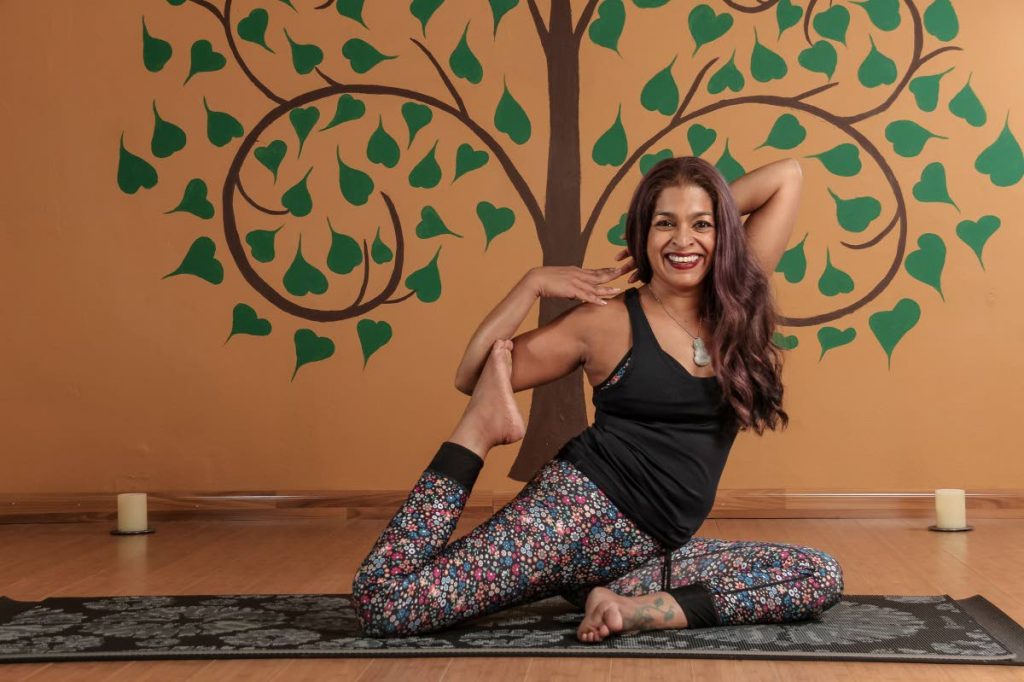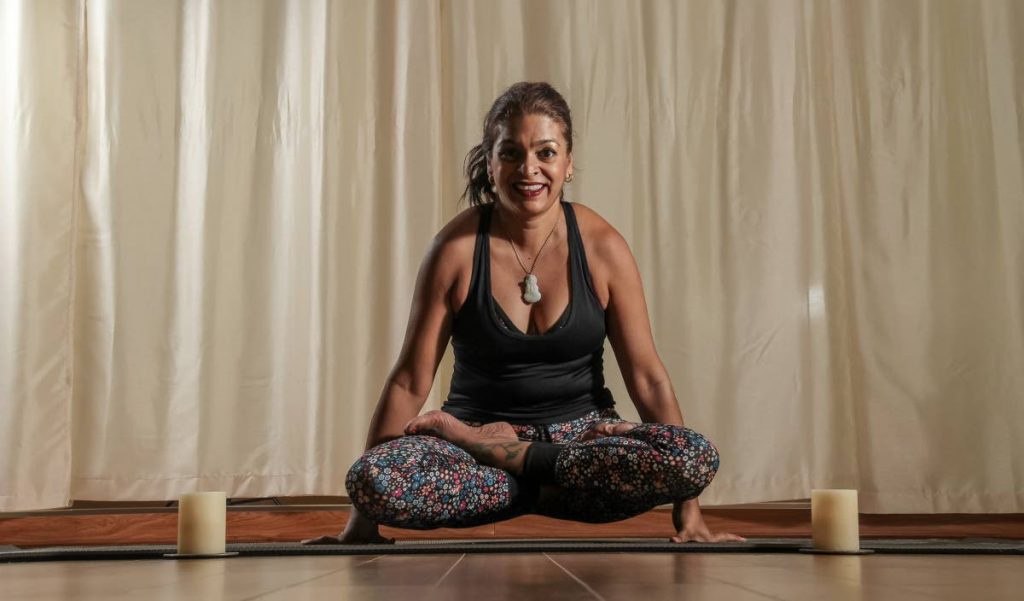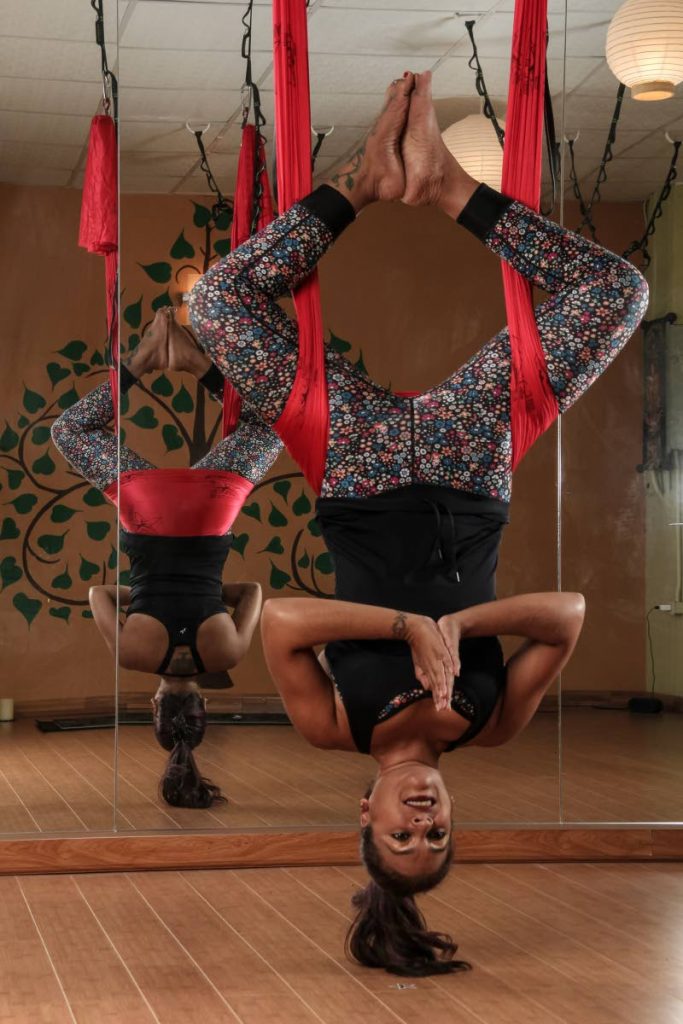Simone Kissoon charts her own path

KIERAN ANDREW KHAN
Simone Kissoon walked away from the corporate world several years ago, first becoming an independent management consultant and later on, a RYT-500 certified yoga instructor. Her recent trip to attend the International Yoga Conference, hosted by the Ministry of AYUSH (Ayurveda, Yoga and Naturopathy, Unani, Siddha and Homoeopathy), in Goa, India allowed her time to reflect on her journey to where she is today. She shares with WMN her unique style of yoga, learnt from near-legendary instructors.
“It was a 180-degree turn for me to start teaching yoga, considering that up to that point I was involved in management consulting, with an educational background in science and technology and an MBA in international marketing too,” Kissoon pointed out. “I first started practising yoga 12 years ago in Saudi Arabia where I was living at the time and just around the time that I was pregnant with my third child. I realised that I was getting immense benefits out of it even after having my third baby. The practice made me want to improve... as well to help others, and so I decided to do a yoga teachers’ training course while across the Atlantic on vacation with my family in Orlando, Florida,” she recalled. This training became the first step towards the RYT-200-hour training that is needed to become an instructor. She went on to complete up to the RYT-500 level.

Back at home, Kissoon first began offering her classes at the Gulf View Community Centre before creating her own space and sanctuary in 2014, The Bodhi Tree Yoga and Health Studio in Endeavour, Chaguanas, where she offers traditional Hatha yoga classes and the popular AntiGravity Fitness programmes.
She wanted to clear up a misconception for readers though: “Yoga is a 5000-year old ancient science. In TT, there is a common association between yoga and one of the major religions here. But yoga has no religion – it’s for everyone and it is a universal practice. For example, in majority Islamic countries such as Saudi Arabia, Dubai and Bangladesh, yoga is today increasingly popular to the point where it has become a sport supported by their ministries of sport,” she pointed out, recalling conversations with other international delegates/teachers at the recent yoga conference in India.
“Practising yoga regardless of its categorisation brings that connection between the mind and the body using the breath. Breath is life, it brings the life force – or what we call prana into the body,” Kissoon explained to WMN. Different people gravitate to different paths/forms of yoga whether it's Bhakti, Karma, Raja, Gyan or Hatha yoga – they all have the same end point which is peace, joy, calm, acceptance, oneness with the universe.
“Some people may find peace and joy while meditating through Raja yoga while others may find it easier to be physically engaged practising Hatha yoga. The key in any of these practices is the use of Prana (breath) to focus the mind and relax the body. According to philosopher Osho, one can even find that meditative peace and joy by disengaging the busy-ness of the mind by simple actions like gardening, knitting, singing or conscious walking," she explained.
The AntiGravity Fitness programme offered at her studio also adds to the overall health and improvement of the body and mind. AntiGravity Fitness is a unique combination of exercises intended to decompress one’s spine and align the body from head to toe while stretching and strengthening one’s muscles.
Inversions done in this practice cause the release of “happy hormones” such as serotonin, oxytocin, endorphins, endophalins, endocaniboids and dopamine which allow practitioners to leave with a sense of joy and accomplishment after each class.

The instructor detailed, “The Harrison AntiGravity hammock is the structural fabric that is used as the fitness/yoga prop to challenge the laws of physics while providing a complete workout that releases one from the compression of gravity. It involves techniques reinvented by its creator Christopher Harrison from yoga, dance, Pilates and calisthenics. The premise of AntiGravity fitness practice is 'In life, hidden in the forces that pull us down is the energy to lift us up!” It works well together with a Hatha yoga practice.”
Another area of specialisation that Kissoon focuses on is called lymphatic yoga which is a specific sequence of asanas (postures) designed to detox the lymphatic system and improve the body’s ability to alleviate disease.
“I am trained in Lymphatic yoga from my teacher, Edely Wallace, a master yoga instructor with training from Brazil, Belgium and USA. After a major road accident in which more than 30 people died, Edely suffered from multiple fractures, surgeries and ensuing complications and was even told by the best doctors that she will never walk again. But she dedicated many years to the study of yoga which helped her recover by simply using breath and practising Pranayama, so much so that today she is an extraordinary yoga master instructor.”
Reconciling this ancient science and way of life of yoga in the context of her daily work as a management consultant, should also be challenging, but Kissoon has found the ideal blend for the two seemingly disparate worlds.

“Whether I am speaking to chief executive officers or to a yoga class, you realise that what fundamentally stops people from doing what they need to do is that they are fundamentally unhappy. As they leave their homes, take to the roads to get to their workplaces, the burden of unhappiness; financial, emotional and mental frustration; a sense of un-fulfilment, and a sense of being lost follows them.”
“Management of corporate and public entities in this country fail to recognise that employees are everyday human beings who also have challenges other than those related to their job or employment, and they expect employees to give their all despite their personal, mental and emotional challenges. This leads to increasing costs in medical claims, absenteeism and declining productivity.
“Major companies, the world over are now recognising the importance of maintaining the mental and physical health of employees by offering Zen office spaces, roof top or outdoor gardens, meditation or quiet rooms, and in-house yoga practice centres and teachers, for people to take a break, to experience some calm to get away for a few minutes to re-centre, so that they can recharge and return to work, feeling re-energised, balanced and more focused.
“We aren’t machines after all, first and foremost, we are human beings and we have to find ways to restore as much energy within as we put out daily,” she said based on her work in the two varying fields.
“Yoga helps to develop a new mindset in people. So while I consult on processes and technology in the corporate world, what it really comes down to is the well-being people,” she said.
This has been confirmed more recently by modern science, which has linked positive health benefits to meditation and other related aspects of yoga. “My recent trip to Goa, India, allowed me to hear from doctors and scientists who saw improvements in patients with non-communicable diseases like diabetes and hypertension, as well as dysfunctions like infertility and mental illness. It was enlightening to also see that the government of India has recognised that their country’s development depends on the health of its people and have created the Ministry of AYUSH in November 2014.
“They have since opened thousands of AYUSH clinics throughout India to assist their citizens to benefit from the gift of these ancient traditions. This shows that there is real value to be derived for people and for companies to find new ways through the old ways. And there is a better way to live life by using preventative practices and mechanisms,” she added.
“There are many, many forms of yoga, and you can easily find the one that suits you the best. I would like see a shift in corporate and government mindsets to engage or hire on staff, on a full-time basis, a trained corporate yoga therapist to help coach, improve and maintain the mental, physical and emotional health of their employees, just as they have traditionally hired on staff a nurse or medical professional to unfortunately treat employees after-the-fact.”

Comments
"Simone Kissoon charts her own path"